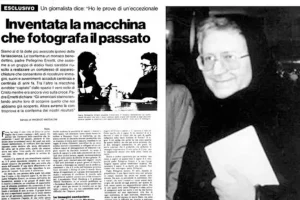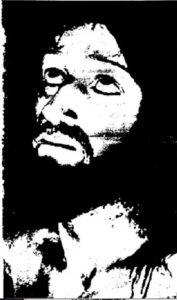This is a reprint of the original and famous 1972 Father Pellegrino Ernetti interview concerning a “time vision” device called the “Chronovisor.” The original Italian title was “Inventata la macchina che fotografa il passato.”
It was a particularly difficult article to find. It took weeks of searching the Internet to find a translated and complete version of the article. The original newspaper that published this work is no longer in existence and copies of the original had been likely been purposefully purged over the years. Even the original magazine cover has proven impossible to find. We are sharing the complete text of the original text and the low resolution images that remain for research purposes so interested readers and fellow Chronovisor researchers can read from to quote the article.
Our goal has been to match the original article with the less than perfect images that we had access to in order to approach a facsimile of the original article layout. We cannot duplicate the exact layout, but feel this is close enough.
Credits
This is a reprint, translated to English from the original Italian. Originally published in Italian in Domenica del Corriere 74/18 (May 2, 1972), 26-29. English Translation by MARK D. WILLIAMS. Edited by ANDREW D. BASIAGO.
EXCLUSIVE: A journalist says: “I have proof of an exceptional discovery that could change the history of humanity.”
Invention of a machine for
photographing the past
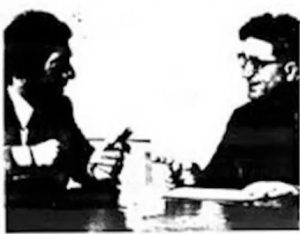
Father Pellegrino Ernetti during the interview. The Benedictine monk has claimed for years that all the sounds emitted from the origins of the world to today can be picked up and reconstructed with suitable equipment. The images as well.
We are beyond the most advanced hypotheses of science fiction. This is confirmed by a Benedictine monk, Father Pellegrino Ernetti, who with a group of 12 physicists realized a complex apparatus that reconstructs images, sounds, and events that occurred hundreds and hundreds of years ago. Among other things, the machine “captured” from space was the true face of Christ on the Cross while he was still alive. Father Ernetti declares: “The Americans are also trying to find out what we have already discovered. Then we will have the rebuttal and the confirmation of our results.”
By VINCENZO MADDALONI
ROME, Italy – Perhaps, I saw the true face of Christ in an image that was “captured” from space. I spoke with the inventor of the machine which, localizing sounds of the past, allows the reconstruction of entire historical events for which there have not been witnesses to verify facts that have marked turning points in human history. I heard, for the first time, things that nobody had ever heard. I saw things that no one had ever seen. I lived for days in another dimension.
This is the story of an extraordinary experience, the first complete documenting of an exceptional discovery that could change human history. It is a fascinating and mysterious story, like all those concerning the discovery of the past. Here is how it started.
A month ago, a person whose name I cannot reveal and who I will call “Mr. X,” told me that Father Pellegrino Ernetti, a monk of the Benedictine order, together with a group of 12 physicists, was able to build a complex apparatus of high precision that reconstructs images, sounds, and events that occurred hundreds of years ago. The group has been working for years on experiments conducted with the same system that astronomers, calculating light years, are able to reconstruct the appearance of a star extinguished for thousands of years. The results obtained are astounding. They “picked up” historical characters, a whole tragedy written in 169 BC and later lost was reconstructed, and the entire life of Christ was photographed. The news is sensational, I agree, and strains the limits of credibility.
For over 15 years, scientists worldwide have been studying the possibility of picking up “news” from space. Last year, the Americans installed at Mountain View, California, a system of 10,000 huge satellite dishes with a diameter of 30 meters each, installed in a radius of 30 kilometers, controlled by one central system and automatically linked to a computer and able to store and process the signals collected from 10,000 terminals. The aim is to capture radio waves coming from other potential distant civilizations, signals inadvertently dispersed into space by residents of other galaxies. So far, however, all results have been negative.
The Russians are also interested in this kind of research. At the recent Conference on Contacts with Extraterrestrial Civilizations, which took place in Soviet Armenia, physicists, astronomers, and biologists from around the world decided to organize an “international study group” to coordinate research on the possibility of establishing contact with extraterrestrial civilizations. Academician Vitali Ginzburg and Professor Nikolai Kardashov, in an article published in the Soviet Union, say that humans already have the means to get in touch with a hypothetical “Planet X,” but they do not hide all the difficulties that the enterprise presents.
The images fit together in many points with the Shroud
I told Mr. X that his story seemed crazy even to me. But Mr. X was not disarmed and showed me a photograph that portrayed a dying Christ on the Cross. He did not explain how it was procured, but said it was one of the many images of Christ “captured.”
Has the true face of Christ been caught and photographed nearly 2,000 years later?
Thus it is shown, from the machine invented by Father Pellegrino Ernetti and a group of 12 physicists, the face of Christ alive on the Cross. According to the theories espoused in the material we are publishing, “every human being, from when he is born to when he dies, leaves behind a double wake: a sound and a visual. With suitable equipment, it is, therefore, possible to hear and see the greatest characters of history.” The exceptional nature of this shocking discovery and the strict secrecy with which, in part, it is still protected, cause them to wait for further confirmation, as Father Ernetti and the rest have said.
Was it really the face of Christ that Mr. X showed me? And if it was indeed the face of Christ, then who was depicted on the Holy Shroud of Turin? Mr. X explained to me that he had had doubts about this, but then it was found that the two images match in many points, and he had concluded that it is likely that the two images represent the true face of Christ: one represents him still alive on the Cross, the other dead.
I could hardly believe it for, above all, one reason: I could not figure out whether what Mr. X said is true, because Father Pellegrino Ernetti and his team have kept this astonishing discovery secret. But even Mr. X knew to give me an answer. All that remained was to question Father Ernetti.
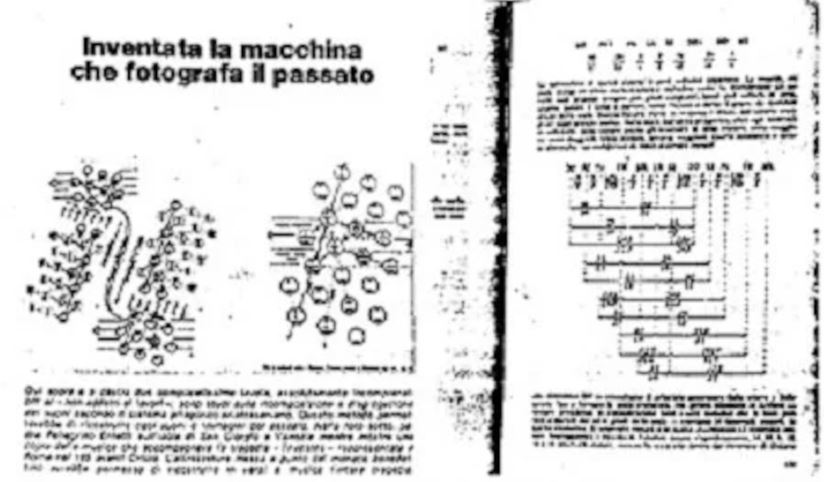
Above are two complicated tables, absolutely incomprehensible to the layman. They are studies on the consolidation and disintegration of sounds according to the Pythagorean-Aristoxenian system. This method would allow one to reconstruct today sounds and images of the past.
Father Pellegrino Ernetti, 47, professor of “prepolyphony” [music before the year 1000] is a well known figure not only in music but also the world of science. He has been claiming for years in conferences, books, and treatises, that all the noises and sounds from the origins of the world until today can, however diluted, be detected with suitable equipment. For all these years, however, Father Pellegrino has been elusive in providing an explanation for his theories and has not provided information on his experiments. At the end of every conference, every interview, the doubts remained: the arguments of the monk seem to work in theory, but how to overcome all the difficulties to be able to realize his hypothesis? Someone concluded: these are the theories of a dreamer. But his superiors do not think so, and even in 1963 the Italian government appointed him professor of “prepolyphony,” at the Benedetto Marcello Conservatory in Venice. In addition, the Cini Foundation of Venice has entrusted him with important positions, such as the organization of a liturgical music center with courses of specialization and perfection of prepolyphonic music. The AISC (Italian Association of Saint Cecily), recognizing the profound preparation of the Benedictine, appointed him national director of the secretary of male religious studies of Italy for sacred music.
What interest would a man in Father Pellegrino’s position have in supporting such theories? If he is so convinced of what he says, although some experiments have been done, what results have they achieved? And why not speak of his experiences in the laboratory? And had the picture of Christ really been captured from space?
I met Father Ernetti in his study at the Conservatory of Saint Cecily in Rome. I spoke with him for over two hours. I told him that I knew of his experiments, the results obtained. He did not deny, indeed, he consented to talk for the first time, provided I not ask him the names of the physicists who form his team and the location of all the equipment for the experiments. Here is the text of the interview.
Recognizing the principle in the Fourth century BC
Question: The “machine,” Professor Pellegrino, you have invented – you and your team of 12 physicists. You are able to reconstruct in the laboratory the voices and stories of the past. Thanks to you, by pressing a button, antiquity can return to us with words, thoughts, and images. A sensational discovery for science and for life itself. A remarkable story. How did you come to this?
Answer: It was possible to achieve with the aid of science and technology what the ancients had already guessed. The Pythagoreans and the Aristoxenians understood already in the Fourth century BC, that through the disintegration of the sounds that one could get the image reconstruction. They only lacked the means.
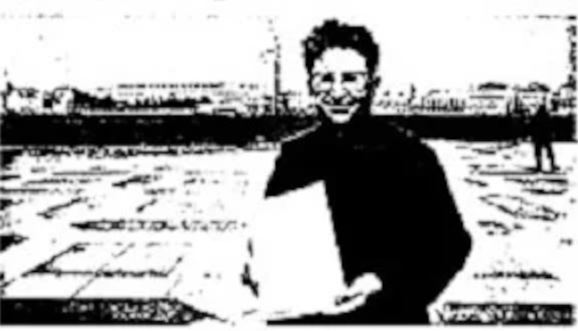
In the photo above, Father Pellegrino Ernetti on the island of San Giorgio in Venice while showing a copy of the music that accompanied the tragedy, Thyestes, which was presented in Rome in 169 BC. The equipment developed by the Benedictine monk would allow rebuilding the whole tragedy in verse and music.
Question: You speak of the disintegration of sounds. What has that got to do with the story of the discovery?
Answer: The story of the discovery begins in 1956. At that time, I began the first studies on electronic oscillation applied to music. I teach prepolyphony and am the holder of the only chair existing in the world for this at the Benedetto Marcello Conservatory in Venice. Prepolyphony studies the first music of the Millennium and precisely that which is from Thirteenth to Fourteenth century BC to the Tenth or Eleventh century after Christ. Included in this kind of study is music that was played at the time of the Babylonians, Assyrians, Egyptians, and Sumerians. Notes, as understood today, had not yet been invented, there were signs, for example, similar to those used in shorthand. Not even the musical staff existed. We must get, in fact, to 1200 AD to find the first notes outlined according to modern use. The study of prepolyphonic music is based on authentic treatises like that of the Gitalankara which is from the Third and Fourth centuries BC, but also on the analysis, and this applies to older music found on clay tablets, papyrus, and tombstones. Needless to say, the studies are quite complex, but no less impressive. In fact, among the many things out there that interested me was the rhythm of ancient music. Was it similar to that of today’s music? I came to the aid of electronics and more precisely to electronic oscillography. The first research was carried out at the Catholic University in Milan with Father Agostino Gemelli. At the beginning, experiments followed detailed studies of the disintegration of the sound. In 1957, I was called by the Cini Foundation to organize a center of liturgical music with specialized courses and training in prepolyphonic music. It was during these courses that I met Professor De Matos, from Portugal, who had done careful studies on the texts of Aristoxenus regarding the disintegration of sound. This was the first “step” towards the discovery. Meanwhile, in 1963, the Ministry of Education instituted the chair of prepolyphony and entrusted it to me. I had the opportunity to call various specialists from around the world to give courses on various branches of the subject. It is with these specialists that I began to develop the whole system that brought us to the sensational discovery.
Equipment is needed to see and hear
Question: What exactly did you do?
Answer: I have the honor of having given the principle of the whole procedure, which is based on a principle of physics, accepted by all, according to which visual and sound waves, once emitted, are not destroyed, but they become and remain eternal and omnipresent, so that each can be reconstructed as energy, because they are energy.
Question: Give an example.
Answer: We make the case with sound – each sound wave is energy that is emitted from a source, whatever it is, whether the human voice directly or the voice reproduced. This sound wave is divided into harmonic sounds, ultrasound, hypersound, hyposound, etc. It is not destroyed, but is in the same situation as the disintegration of matter in atomic theory. Matter, as we know today, may not only be disintegrated at the atomic level, but also up to its smallest components, and with special processes it can be reconstructed in its original form – this is possible because it is energy. Of course, for reconstructing it takes certain devices, but that’s another problem. The principle remains, namely, that no energy is destroyed, it all becomes transformed. The objection, “I do not see it,” “I do not hear it,” does not apply, so do not believe it. Ultrasound, for example, we do not hear with our limited hearing, we hear whatever sounds our ears allow, but there are also animals who hear ultrasounds and we know that. Hence, the fact that we do not hear and see things does not mean that they do not exist, just that you need certain equipment for hearing and seeing them. That’s why I want to clarify that my studies have nothing to do with parapsychology or metaphysics, where we try to give an explanation for everything such as voices, sounds or pictures from the afterlife. No, this is strictly a scientific matter, and that means given the principle that sound waves are energy, it follows that they can be captured and then reconstructed.
Sound can be transformed into light
Question: According to you, this is the only way to recapture the “voices” from space, a system that is based on the laws of physics. But what about how you manage to capture the image?
Answer: Even the visual wave, like the sound wave, is energy and each material element is formed of light and dissolves into light. From this we can deduce, and it is scientifically proven, that energy is the “light” which forms all of the various elements that we call matter. And if light is the primordial element that forms all the other energy inherent in matter, it means that since the other energies are eternal and can be reconstructed, so much more visual waves can be reconstructed, since they are the mother of all other energy. So, when we read in the Bible that on the first day God created light, it means He created the item from which all the other elements were created. Sound, for example, and today it is scientifically proven, generates light and is converted into light, and vice versa. It follows, then, that the sound wave is not destroyed because along with the light wave it contributes to the formation of all other aggregate matter from which energy can, therefore, be reconstructed, then captured.
Question: Captured, but how?
Answer: With the use of suitable equipment. Our team was the first in the world to build it. The equipment consists of a series of antennas to allow tuning of the individual voices and images. We know that every human being from when he was born to when he dies leaves behind himself a double wake: a visual and a sound, a sort of identity card for each different person. And based on this different identity card one can reconstruct the single person in all his deeds and his sayings, and for this reason we are now able to hear and see again the greatest people in history.
Question: Father Ernetti, I have learned that so far you’ve come to the point of being able to reconstruct the exact pronunciation of certain ancient languages? Among other things picked up were you able to locate and then reconstruct Thyestes, a tragedy performed in Rome in 169 BC during the “Ludi Apollinares,” which took place at the Temple of Apollo, between the Circus Flaminius and the Forum. Composed by Quintus Ennius, the work is written in a difficult and irregular Latin – a revolutionary work, considering the times in which it was composed. A tragedy that did not follow the pattern of classical poetry, and this was perhaps one of the reasons why it was shelved and was destroyed. There remained, up until your discovery, only some fragments that left one to just imagine the beauty and validity of the work. Thanks to these tools you have succeeded, capturing it, seeing it as it was represented. I guess you have seen the faces of the spectators, the actors’ masks. . . .
Answer: Do not drag me into an area about which I still cannot speak.
The machine may pick up thoughts
Question: But when will you speak, Father Ernetti?
Answer: When there is confirmation of our experiments. The Americans are also trying to find out what we have already discovered. Only then, when we can compare the results of our experiences with them, can we give the official news of the discovery.
Question: So the team is not yet sure of the validity of the experiments.
Answer: Not exactly. Verification was done with people easy to pick up because they only recently disappeared and on which there is vast historical documentation, such as Benito Mussolini and Pope Pius XII. Their images were then compared with the movies and recordings of the time, with the results being more than satisfactory.
Question: Father Ernetti, this is a picture of Christ taken from your “machine.” Do you have any additional comments to make?
Answer: Father Ernetti looks at the photo, smiles with pleasure, and says: The time will come when I can speak.
Question: I agree. Wait for confirmation from the Americans. But nevertheless is there nothing more to add?…
Answer: This machine could cause a tragedy.
Question: How?
Answer: Because it takes away the freedom of speech, action, and thought. In fact, even thought is an emission of energy, so it could be captured. It will be possible, i.e., by means of the machine, to know what the neighbors or the opponent thinks. There would be two consequences: either a massacre of humanity or, something difficult, a new morality would arise. That is why it is necessary that these devices do not become available to everyone, but remain under the direct control of the authorities.
Question: Until when?
Answer: Until man learns to act for the greater good.
[For the sake of space, a photograph and description of the Shroud of Turin was not included.]

